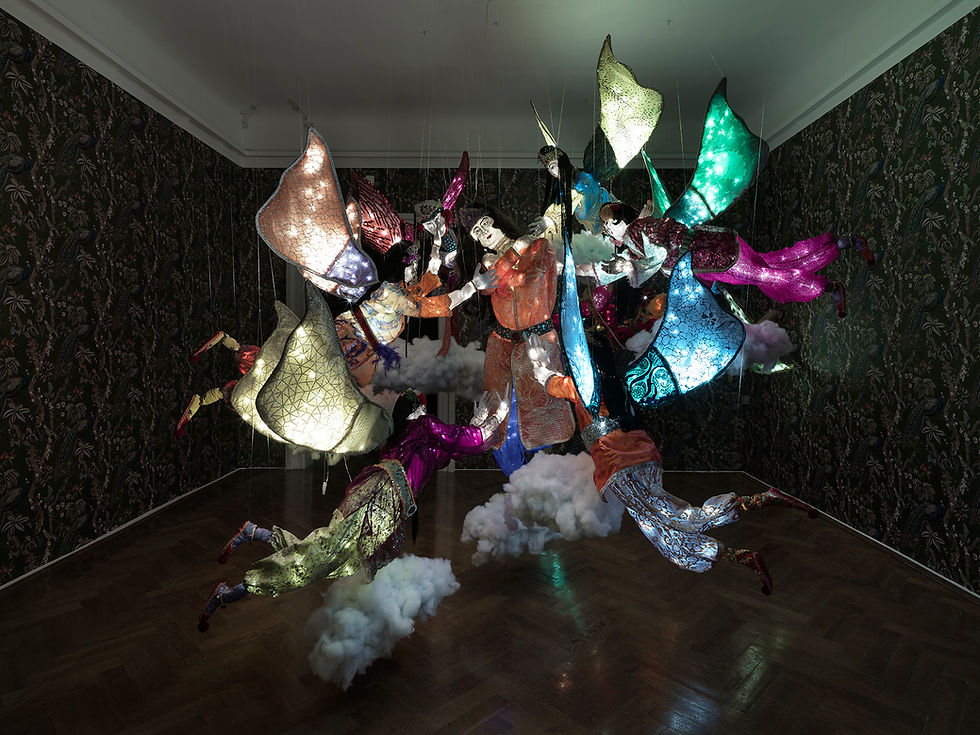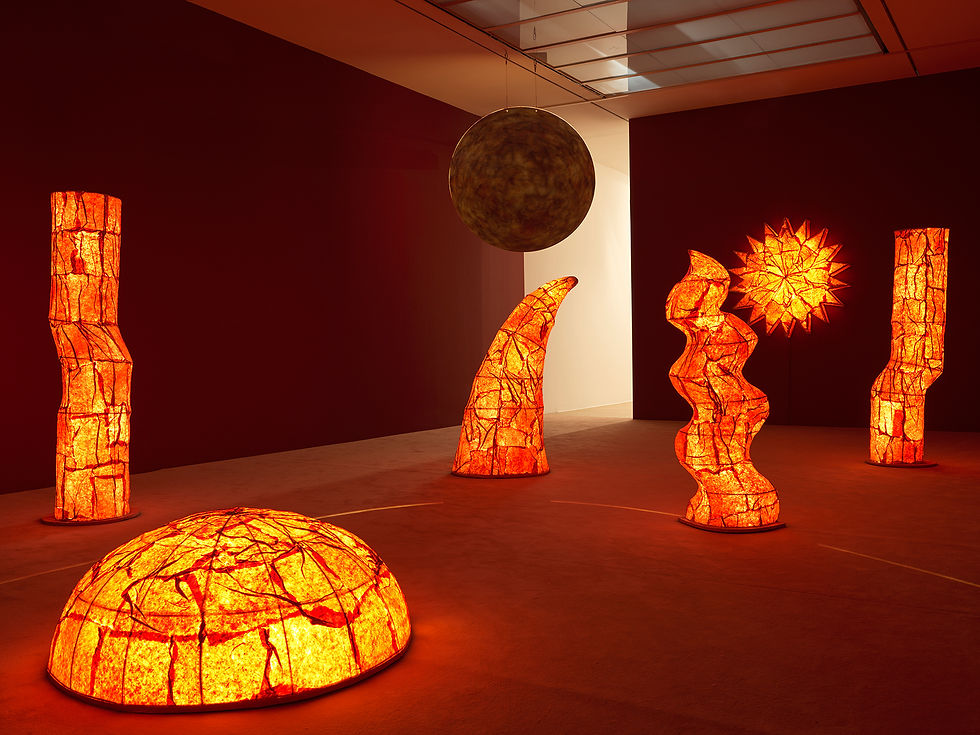Where Sticks Become Swords: Ljubljana’s 36th Biennial of Graphic Art
- C-print

- Aug 7
- 5 min read

Art is the small but meaningful point from which it is possible to dream of – and demand – peace and freedom, claims the Spanish curator Chus Martínez in the exhibition text for Ljubljana’s 36th Biennial of Graphic Art. By naming the biennial The Oracle – on Fantasy and Freedom, she wants to remind us on its seventieth anniversary how every artistic manifestation can be likened to an oracle that offers reflection and advice on which path to continue on. Another hot summer marked by the west’s petrifying resignation in the face of the ongoing genocide in Palestine, this is a timely but yet ambitious starting point.
The biennial, the oldest for graphic art, was started in 1955 and is said to have enabled meetings between artists from both sides of the wall during the early days of the Cold War. Today, it no longer focuses solely on graphic art; in fact, it is barely present in this edition. Instead, Martínez takes its cue from the Slovenian puppet theatre scene of the 1950s. Following the starting point of the oracle, a new layer unfolds from a nationally well-known performance piece in which the character Žogica Marogica is kidnapped and only can be saved if the audience collectively blows the evil dragon away. With threads attached to all parts of its puppet body, Žogica becomes the portal figure in the exhibition's investigation of human desire for control, artificial intelligences, bodily agents and folklore in a way that makes me think of Norwegian artist and author Matias Faldbakken's peculiar novel We Are Five from 2021. Through the meticulously hand-crafted puppet installations of Slovenian artist Silvan Omerzu, which recur in all exhibition venues of the biennial, these questions continue to speak with the different localities and contribute to a rhythm of recognition.

In a scorching Ljubljana, the locals seem to have fled to the mountains, or perhaps the coast, and left the city center to the tourists. While I am visiting, the European Cheerleading Championship is taking place in the sports arena right next to the National Museum of Contemporary History of Slovenia. In the evenings, synchronized pyramids of powerful bodies spontaneously appear on the bridges along the Ljubljanica River, to the delight of the tourists. Inside MG+ (Moderna Galerija) it is cool and relatively dark. In the newly produced video work Open World by Kiev-based filmmakers Yarema Malashchuk and Roman Khimei, we follow a boy's return to the Ukrainian village he left because of the war, and now revisits with the help of a robotic dog. The piece is installed as a gaming setup with the player/narrator placed on a smaller screen to the right, just in front of the larger image of the village where the boy revisits his old milieu via the robot dog, as if strolling in an open world game. It’s a heart-wrenching and at the same time complex representation where technology is not only a threat of extinction but also a promise of togetherness and reunion.


The same museum houses, among others, Jane Jin Kaisen's watery video November (with wall-hung poetry by Mara Lee) that meditates on ending times, and Derek Tumala's dreamlike paper and light installation Island in the Sun that invokes the thirty-six-degree heat outside, in a contemplation of the increasingly brighter sun. In the basement, I stop in front of Manuela Morales Délano's wall of pastel drawings of abstracted mountains and seas on colored paper above a bright yellow carpet, and I am captivated.
An emphasis on a strong sensuality seems to be characteristic of this year's biennial. A breadth of expression, the absence of excessively text-heavy or archival works and a certain predilection for scenic installations in darkened rooms form a world of its own in the different buildings, whose own marks of Slovenian history softly have been woven in. The biennial is not of the larger kind; this year 25 artists are exhibiting works in five venues spread between the city center and the green foliage of the Tivoli Park – and the vast majority of the works are commissioned for the project. One of the exceptions is Joan Jonas' video To Touch Sound (from 2024), that depicts a sperm whale giving birth, continuing the artist's long-standing investigations of more-than-human entanglements and matrilineal societies. A more queer approach to questions of reproduction and kinship is found in Gabi Dao, who in the sci-fi film Sweet Blood in Stagnant Waters cuts rapidly between the members of a family of humanoid cyborgs where one sister is pregnant with a mosquito. This year, the Ljubljana Biennial is a fruit with many kernels, and by centering on play and desire, it sprinkles its seeds around.


In a bright room with carefully installed wooden sticks, alongside drawings and photographs of them, Noor Abed examines the overlaps between dance and resistance. The material in a study of a stick: movement notations and notes on defiance is collected and recorded in various locations in Palestine, using the very landscape as the story’s protagonist. In Abed’s investigation, the stick replaces the traditional sword in the Palestinian folk dances that inspired the work, and through the body’s movements the stick is charged with the potential for action and resistance. Like the biennale as a whole, the work emphasizes the power of human imagination in order of creating alternative futures that serve the many. In a world whose leaders don't intervene during an ongoing genocide, there is a acute urgency to invigorate our dreams, visions and demands of a better future, as they stimulate action. Addressing both body and mind, the exhibition succeeds in accentuating the possibilities that come with practicing the techniques of the imaginary that we call art.
/Caroline Malmström
Caroline Malmström is a curator and writer, educated in art history and comparative literature, connecting local issues of ecology, history and participation through artistic production and radical play. In a number of projects, exhibitions and publications, she has invited artists and audiences to explore sites, archives and possible futures together at institutions such as Art Lab Gnesta, Carl Eldhs Studio Museum, Konstfrämjandet and Botkyrka konsthall. Currently she is the co-curator of Göteborgs Konsthall’s two year program Field Studies, while the konsthall is operating nomadically before re-opening in its new premises 2026.
36th Ljubljana Biennale of Graphic Arts “The Oracle: On Fantasy and Freedom” is on display until October 12, 2025.


